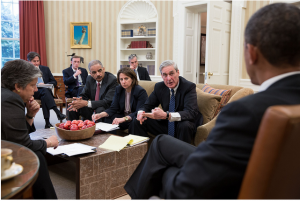What Kind of Intelligence Does the HIG Expect to Get from Anas al-Libi?
There has been all manner of commentary about the rendition and detention on a poorly functioning ship of Abu Anas al Libi. There are credulous claims about the humanity of the High Value Interrogation Group’s tactics that nevertheless remain officially classified. There’s the growing awareness that al-Libi’s case differs from Ahmed Warsame’s in several key ways. And then there’s John Bellinger, trolling the Obama Administration for violating rules the Bush Administration did not in superb fashion.
These are important questions. But they distract from another important question.
What kind of intelligence do they really expect to get from al-Libi?
The explanation for his capture has focused on his alleged role in the 1998 Embassy Bombings. While there are no statutes of limitation for murder, that’s nevertheless an event that took place over 15 years ago. Even some of the analysts we often rely on — not to mention his family — suggest he hasn’t had an active role in al Qaeda for over a decade, or at least since he returned home to Libya 2 years ago. Lisa Monaco offered weak claims about the importance of al-Libi.
During an appearance on PBS Newshour, Deputy National Security Adviser Lisa Monaco repeatedly referred to Abu Anas Al-Libi as a “member” of Al Qaeda. However, she stopped short of calling the Libyan-born Al-Libi a “senior operational leader”—a phrase which seemed to have special significance when the Justice Department evaluated the legality of lethal force against U.S. citizens and is also believed to apply to targeting of foreign nationals outside combat zones.
Newshour reporter Jeffrey Brown asked Monaco about whether Al-Libi posed an “imminent” threat to Americans, but Monaco wouldn’t say that and also seemed to avoid declaring that he was an Al-Qaeda operative or even a leader of the group.
“Al-Libi did pose a threat to the United States as a senior al-Qaida member and somebody who is also charged in an indictment for his role as part of the Al Qaeda worldwide conspiracy,” Monaco declared.
This is, at the least, a significant difference from Ahmed Ghailani (who was seized with an active cell in Pakistan and interrogated for years about that active cell before being tried for his role in the Embassy Bombings) and Ahmed Warsame (who was seized for his active role in working with AQAP and al-Shabaab), though it perhaps resembles Suleiman Abu Ghaith.
I’m not saying al-Libi had no active role in terrorism. The timing — the raid took place at the same time as the strike on Abdulkadir Mohamed Abdulkadir, who allegedly helped plan attacks in Kenya — might suggest al-Libi played some role in the Westgate Mall attack and other operations in Africa.
Perhaps the most complete explanation for why al-Libi is a current threat is this description.
An unclassified report published in August 2012 highlighted al Qaeda’s strategy for building a fully operational network in Libya. The report (“Al Qaeda in Libya: A Profile”) was prepared by the federal research division of the Library of Congress (LOC) under an agreement with the Defense Department’s Combating Terrorism Technical Support Office (CTTSO). [See LWJ report, Al Qaeda’s plan for Libya highlighted in congressional report.]
Abu Anas al Libi has played a key role in al Qaeda’s plan for Libya, according to the report’s authors. He was described as the “builder of al Qaeda’s network in Libya.”
Al Qaeda’s senior leadership (AQSL) has “issued strategic guidance to followers in Libya and elsewhere to take advantage of the Libyan rebellion,” the report reads. AQSL ordered its followers to “gather weapons,” “establish training camps,” “build a network in secret,” “establish an Islamic state,” and “institute sharia” law in Libya.
Abu Anas al Libi was identified as the key liaison between AQSL and others inside Libya who were working for al Qaeda. “Reporting indicates that intense communications from AQSL are conducted through Abu Anas al Libi, who is believed to be an intermediary between [Ayman al] Zawahiri and jihadists in Libya,” the report notes.
Al Libi is “most likely involved in al Qaeda strategic planning and coordination between AQSL and Libyan Islamist militias who adhere to al Qaeda’s ideology,” the report continues.
Al Libi and his fellow al Qaeda operatives “have been conducting consultations with AQSL in Afghanistan and Pakistan about announcing the presence of a branch of the organization that will be led by returnees from Iraq, Yemen, and Afghanistan, and by leading figures from the former LIFG.” The LIFG refers to the Libyan Islamic Fighting Group, an al Qaeda-linked jihadist group formed in Libya in the 1990s.
The suggestion that al-Libi might be the liaison between Ayman al-Zawahiri and extremists in Libya (extremists we helped to overthrow Qaddafi) is more interesting, particularly given Libya’s public objections to al-Libi’s rendition. Perhaps the ultimate plan is to hold al-Libi responsible for Benghazi (though interrogating him in a floating prison might endanger any charges if he was involved, which would be a big problem given the need for some finality on Benghazi). But it might raise interesting questions about whether the extremists we helped in Libya really constitute al Qaeda, or instead constitute a legitimate force within that country.
As of now, however, the US public story is that we captured this guy who has been living in the open for two years for a crime he committed 15 years ago. And that instead of whisking him immediately to NY to stand trial for that crime, we are instead pissing off the Libyan government and nudging up against a slew of domestic and international laws by conducting a floating interrogation from which we might learn only decades old facts. If that’s the story (and again, I suspect the government at least claims there is more), it makes all the legal and ethical issues surrounding his detention all the more problematic.

